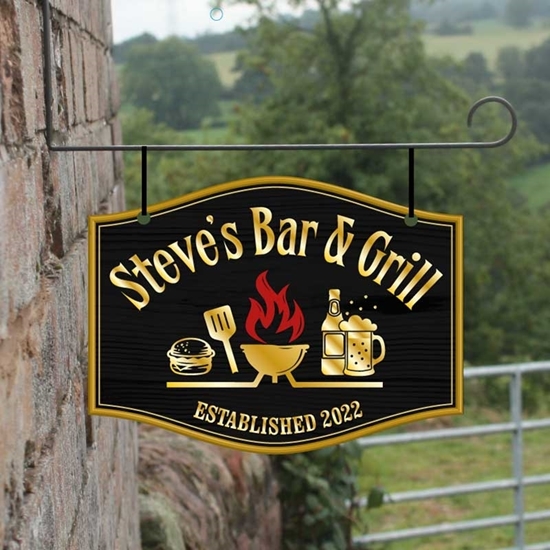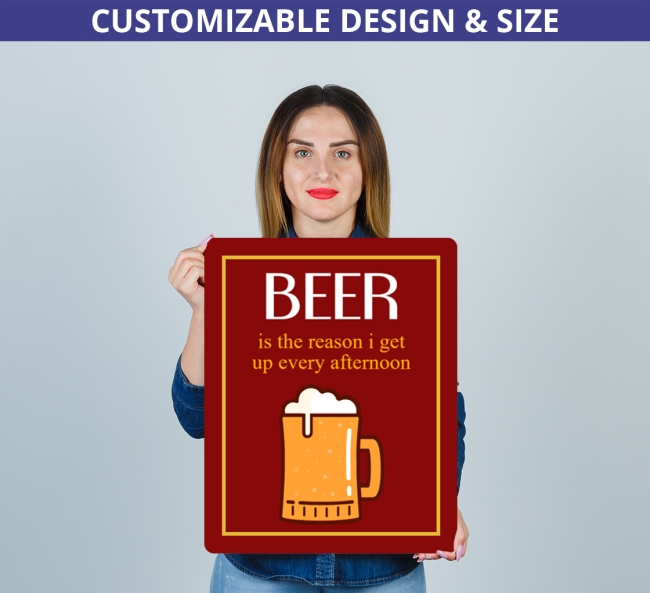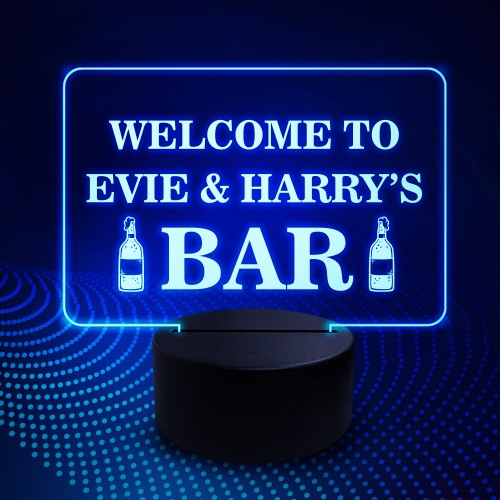New Advice To Deciding On Bar Signs
New Advice To Deciding On Bar Signs
Blog Article
How Can Bar Signs Differ In Relation To Their Location?
The location of the sign can make a huge impact on the effectiveness of bar signs. The design, the purpose, placement, etc. are tailored to specific locations. Below is a breakdown on how bar signs differ depending on where they are located: Exterior Signs
Objective: To draw patrons from outside, and to establish the bar's brand identity.
Highlights: Big, attractive features, usually illuminated to improve the night's visibility.
Materials: Sturdy materials such as neon, metal, LED or weather-resistant vinyl.
Example: The bar's main sign The logo sign and the marquee above the entrance.
2. Signs of entry
Begin by welcoming clients and providing the initial details.
Features: Clean and inviting, usually using branding elements.
Materials: Wood or metal signs.
Examples are "Welcome Signs" as well as operating hours and special announcements.
3. Interior wall signs
Purpose: To enhance decor, provide information, and create ambiance.
Its main feature is that the size and design of the rugs can be varied to suit any decor.
Materials: Wood, metal, chalkboard, acrylic.
Examples are menu boards, décor signs and inspirational quotes.
4. Signs for Behind the Bar
Make sure to highlight important information, such as the bar's name, its signature drink or any specials.
Highlights: Brightly lit and well-lit, it serves as a focal piece.
Materials: LED, neon, digital display, chalkboard or other materials.
Examples include signs for bar names and drink specials boards.
5. Ceiling and hanging signs
Goal: To improve décor or to provide instructions from above.
Features Suspended from ceiling, it is visible from different angles.
Materials These are lightweight materials, such as acrylic, foamboard, or metal.
Examples: Directional Arrows, decorative hanging signs as well as themed props.
6. Tabletop Signs
Goal : To provide patrons with specific details about their table.
Features The display is easy to read when close up.
Materials: Acrylic, wood Laminated paper.
Examples include menus for drinks, table numbering promotional cards, and QR code stands.
7. Restroom Signs
The purpose of this signboard is to clearly identify the exact location of restrooms.
Features: Highly visible, often with clear symbols and text.
Materials: Metal, plastic, wood.
For example, men's and women's restroom signs.
8. Directional Signs
Guide patrons in different parts of the bar.
Labels and arrows that are easily readable.
Materials: Metal, acrylic, wood.
Examples: Signs leading to restrooms, exits or other seating areas.
9. Window Signs
The purpose is to draw the attention of passers-by and to provide information on the bar.
Features: Visible from outside, usually including lighting.
Materials: Vinyl decals, neon, LED.
Examples: advertising signs, announcements of hours and other events.
10. Signs for events and promotions
Purpose : To inform customers of seasonal or special deals and events or promotions.
Highlights: Attractive and often temporary.
Materials: Vinyl, foamboard, chalkboard.
Some examples: Event banners or posters.
Location Specific Beware of
Visibility
The signage for the entrance and exterior The signs must be visible from afar to attract potential customers.
Signs for behind-the-bar and inside the bar must be placed strategically for maximum impact and ease of reading.
Durability
Exterior Signs. Choose materials that are resistant to the weather.
Interior Signs are a good choice as they can be created using a range of different materials.
Aesthetic integration
Decorated and Behind-the-Bar-Signs They should be a perfect complement to the interior design of the bar and style.
Signs for directions and informational purposes are meant to be useful and yet blend with the décor.
Functionality
Directions and restroom signs They must be easily readable and clearly displayed to ensure that customers can find their way around.
Promoter and event signs are to be temporary or able to be changed to reflect current promotions.
Lighting
Signs for windows and exteriors are typically illuminated to increase their visibility at night.
Interior and Behind Bar Signs and signage. Make use of lighting to highlight areas or create a mood.
By modifying the design and materials of bar signs according to the place of the sign, bar owners can enhance the look and function of their establishments. This will create an inviting and harmonious ambience for customers. Take a look at the recommended cocktail bar sign url for blog info including the staying inn pub sign, personalised beer sign, sign for garden bar, garden pub signs, bespoke bar signs, design your own bar sign, personalised sign for bar, garden pub signs, pub signs for home bars, pub signs for garden bar and more.
What Is The Distinction Between Bar Signs And Other Types Of Signage In Terms Of Light?
The bar signs differ greatly when it comes to lighting. This affects their visibility and ambiance as well as their overall impact. Here are the main ways in which lighting variations influence the appearance of bar signs:1. Neon Signs
Characteristics: Bright, colorful, classic.
Lighting: Utilizes a gas-filled fluorescent tube which emits light when powered by electricity.
Applications for this product It's great to create an old-fashioned or retro look.
Advantages: Highly noticeable, even from a distance and a nostalgic appeal.
The material is delicate and expensive to fix.
2. LED Signs
Characteristics: Energy-efficient, versatile, modern.
Lighting: Light-emitting Diodes (LEDs) create a bright, vibrant and glowing illumination.
Uses: Great for outdoor and indoor signage, programmable displays and lighting effects that are dynamic.
The advantages are that they last for a long time and energy efficient. You can also program them to display colors or animations.
The initial cost may be high but you will save money on maintenance and energy.
3. Signs with Backlight
Characteristics: Elegant, sophisticated, subtle.
Lighting: Place LEDs and fluorescent lights behind transparent surfaces to create soft diffused light.
Uses: Common for modern bar menu boards, signs, as well as branding components.
Benefits: Enhances the readability of small print in dim lighting conditions.
Advantages: More complicated installation and higher upfront cost.
4. Signs Edge-Lit
Characteristics: Sleek, contemporary, stylish.
Lighting Utilize LEDs to light the edge of a sign, typically acrylic.
Applications: Excellent for modern, minimalist designs, often used to create directional or informative signs.
Features: Gives sophisticated, distinctive designs. It is energy efficient.
Advantages
5. Ambient/Accent Lighting
Characteristics: Subtle, atmospheric, decorative.
Lighting: Make use of indirect light sources to emphasize or highlight the appearance of signs.
Uses: Improves the atmosphere and is commonly used to highlight art or theme-related decor.
Benefits: Creates an atmosphere that is warm and inviting.
Negatives: Might not provide sufficient direct illumination to ensure readability.
6. Marquees and Signs
Characteristics: Bold, theatrical, eye-catching.
Lighting: Uses multiple LEDs and light bulbs to illuminate the sign.
Signs for exterior use, event promotion, and vintage-style cinema are popular.
The design is highly visible and draws the attention of others.
The drawbacks are that it can be expensive and requires regular maintenance.
7. Projection Signs
Characteristics: Dynamic, innovative, versatile.
Lighting Projectors project images and light onto the surface.
Uses: Ideal for events, promotions that are temporary and interactive displays.
Simple to alter There is no need to use physical signs.
Advantages: Needs a controlled lighting environment, can be less effective in bright settings.
8. Fluorescent Signs
Characteristics: Bright, cost-effective, traditional.
Lighting Tubes with fluorescent light sources are used to illuminate.
Typically, they are used on large outdoor and indoor signs.
Benefits: Bright and effective for large signage, affordable.
Disadvantages : They are less efficient in terms of energy efficiency than LEDs and can produce more harsh lighting.
Things to Consider Regarding Lighting
Visibility
Neon LEDs and neon signs can be extremely effective in grabbing people's attention, especially in low-light conditions.
Backlit and Edge-Lit Signs: Great for enhancing the readability of signs and achieving the appearance of polished.
Energy Efficiency
LED signs are energy efficient and last for for a long time.
The fluorescent and neon signs are not as efficient in energy use and neon signs are more fragile.
Aesthetic Appeal
Neon signs and marquees are perfect for vintage and retro aesthetics.
The ideal choice for modern and clean designs are signs that have an edge lit with backlighting.
Ambient Lighting: Boosts the overall ambiance and atmosphere.
Maintenance
LED Signs are long-lasting and low-maintenance.
neon signs as well as fluorescent signs They require more frequent upkeep and repairs could be possible.
Cost
LED Backlit Signs - More expensive initial costs, but less ongoing expenses
Fluorescent signs are less expensive initially, but they consume more energy in the long-term.
Flexibility
Projection and Programmable LED Signs Provide high flexibility in moving displays and dynamic content.
Traditional Signs - Less flexible, but can often give the desired look.
Bar owners can enhance the visibility of their bars and create the ambience they would like to create by selecting the correct type of bar sign lighting. They also have the ability to convey their brand's name or promotions as well as other information to their customers. See the most popular continue reading on cocktail bar sign for website advice including hanging pub signs for sale, outdoor personalised bar sign, the staying inn pub sign, pub sign hanging, personalised garden pub sign, the staying inn bar sign, home made bar sign, bar hanging sign, bar wall signs, hanging pub signs for sale and more.
What Are The Differences In Bar Signs That Are Based On Budget?
Bar signs can be subject to various costs according to factors such as dimensions, the kind of material, degree of personalization, and the specifications to be installed. Bar signs are different in terms of cost. Material Cost
Signs made with foam board or vinyl decals are typically cheaper.
Signs made from high-cost materials: Because of the cost of materials and the quality of workmanship, signs made from premium materials like wood, metal or even custom glass are more expensive.
2. Design Complexity
Simple Designs: Signs that feature simple designs, with no text and graphics and signs that are simple in appearance, usually cost less.
Signs with intricate designs, custom typography or special effects, like LED, neon requires more knowledge as well as time. This adds costs.
3. Customization
Standard Options: Templates that are predesigned or off-the-shelf signage choices can be economical than custom-designed signs.
Customized Features - Custom branding, logos colors and finishes can add to cost, but can create unique branding opportunities for the bar.
4. Size and Scale
Tabletop signs, Decals, or small wall-mounted signs are generally more affordable due to the lower material and production Costs.
Large-Scale Displays: The use of large signs, outdoor marquees and illuminated displays require more materials, labor and cost.
5. Lighting
Non-illuminated Signs - Simple signs with no lighting components tend to be less costly than illuminated ones because they are made with fewer components and require less electrical installation.
Illuminated Signs. Neon, LED and backlit signs cost more due to the wiring, the additional materials and the energy required.
6. Installation
DIY Installation. Signs that can be easily put up by bar owners or staff are much more cost effective than those which require professional installation.
Professional Installation - Large signs or complex ones may require a professional installer. It is costlier however, installation is carried out properly and in accordance with the safety regulations.
7. Quantity
Bulk Orders. When you order multiple signage kits or signs could be eligible for a volume discount or lower unit cost than one-time orders.
Signs that are ordered as single pieces, or other items could be more expensive due to production and set-up cost.
8. Maintenance and Long-Term Costs
Signs that require minimal upkeep: Signs that are low-maintenance and last longer could reduce maintenance and replace cost.
Signs with high maintenance requirements: Signs that have intricate designs and delicate materials, or require specialized maintenance could cost more.
9. Budget Allocation
Budget Allocated: By setting an allocated budget for signage, bar owners are able to prioritize their expenditure to concentrate on crucial elements such as branding, visibility, and durability.
Cost-Benefits Analysis: Assessing return on Investment (ROI), bar owners are able to make educated decisions about where to allocate budgets to maximize impact.
Financing options
In-person Payment: Paying for signage upfront could be cheaper than financing via installment plans or loans as it avoids interest charges and financing costs.
Financing Options: Certain signage suppliers offer financial plans or payment schedules to spread out the cost of their signage over a certain period of time. This allows bar owners with low upfront capital to access higher-end products.
Bar owners can choose signs that represent their brand's image effectively. It enhances customer service and assists them in achieving their goals overall by taking into consideration these elements. Follow the top see page about hanging signs for more advice including home made bar sign, make a bar sign, gin bar sign, pub signs for garden, home bar pub signs, the staying inn bar sign, indoor bar signs, indoor bar signs, outdoor home bar signs, personalised hanging bar sign and more.